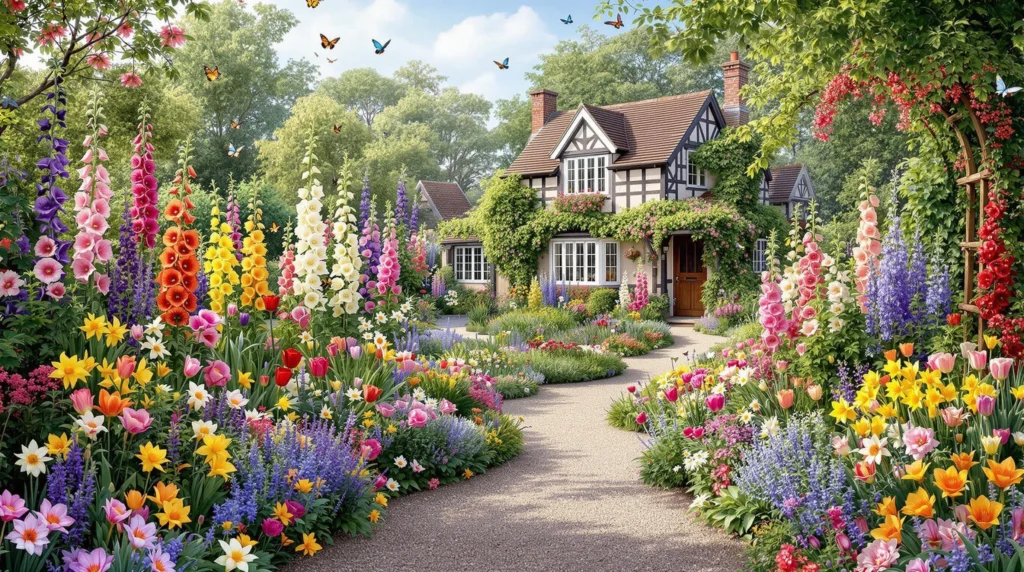The Charm of Classic Cottage Gardens: A Year-Round Color Display
Classic cottage gardens captivate with their seemingly effortless beauty and continuous color throughout the seasons. These enchanting spaces blend structure with wildness, creating a harmonious display that evolves month after month. You’ll find the secret to their year-round appeal lies in thoughtful plant selection and strategic placement. Traditional cottage gardens feature an artful mix of flowering perennials, climbing roses, sturdy biennials, and self-seeding annuals that create overlapping bloom cycles. By combining early spring bulbs, mid-season flowering shrubs, and late-blooming perennials, you’ll enjoy waves of color from the first snowdrops to the last autumn asters. The cottage garden style embraces a certain comfortable dishevelment where plants spill onto pathways and mingle freely, creating that quintessential romantic atmosphere that’s both inviting and nostalgic. This approach doesn’t just please the eye—it creates resilient ecosystems that support pollinators and beneficial insects throughout the growing season.
10 Spring-Blooming Cottage Garden Favorites

Spring brings the first vibrant colors to cottage gardens after winter’s dormancy. These early bloomers set the stage for a season-long display while capturing the essence of cottage garden charm.
Delicate Daffodils and Cheerful Tulips
Daffodils arrive as spring’s cheerful harbingers, creating waves of gold, white, and peachy tones throughout the garden. Plant these resilient bulbs in clusters of 7-12 for dramatic impact, allowing them to naturalize and multiply each year. Pair them with tulips for a stunning color combination—choose cottage-friendly varieties like lily-flowered, parrot, or fringed tulips in soft pinks, purples, and creams that blend harmoniously with other spring bloomers. Both flowers thrive when planted in fall, requiring well-drained soil and at least 6 hours of sunlight for optimal flowering.
Sweet-Scented Hyacinths and Crocus
Hyacinths deliver intoxicating fragrance that fills the spring garden with their perfume while providing rich purple, pink, blue, and white blooms. These compact powerhouses work beautifully along garden edges or near seating areas where their scent can be fully appreciated. Combine them with early-blooming crocus, which push through barely-thawed ground in late winter with their jewel-toned cups of purple, yellow, and white. Plant crocus in drifts beneath deciduous trees or scattered throughout lawn areas for a naturalized look. Both bulbs multiply reliably year after year, creating increasingly impressive displays with minimal maintenance.
Romantic Bleeding Hearts and Columbines
Bleeding Hearts (Dicentra spectabilis) captivate with their dangling heart-shaped blooms in pink or white, arching gracefully above feathery blue-green foliage. These woodland natives prefer partial shade and moisture-retentive soil, reaching 2-3 feet tall and providing structural interest even after blooming. Columbines (Aquilegia) offer star-shaped flowers with distinctive spurred petals in a rainbow of colors, dancing above delicate ferny foliage. These self-seeding perennials cross-pollinate freely, creating unique color combinations that surprise gardeners each spring.
Forget-Me-Nots and Primroses
Forget-me-nots (Myosotis) create clouds of tiny blue flowers that weave themselves throughout the spring garden, filling gaps between perennials with their sky-blue blooms and fuzzy foliage. These biennial plants self-seed prolifically, establishing charming colonies that return year after year. Primroses (Primula) contribute jewel-like clusters in yellow, pink, purple, and red, thriving in the moist, partially shaded spots of cottage gardens. Their crinkled leaves and bright flowers bring early color to woodland edges and north-facing borders.
Fragrant Peonies and Iris
Peonies serve as cottage garden anchors with their massive, fragrant blooms in shades from pure white to deepest burgundy. Plant these long-lived perennials in full sun with excellent drainage, giving them space to mature into spectacular specimens that can live for decades. Bearded iris offer sword-like foliage and intricate blooms in nearly every color imaginable, with ruffled petals and distinctive beards adding textural interest. Both plants provide excellent cutting flowers while establishing the structural backbone that supports more delicate cottage garden companions.
12 Essential Summer Cottage Garden Stunners

As spring blooms fade, summer brings a new wave of spectacular flowering plants to take center stage in your cottage garden. These twelve summer stunners deliver both drama and enduring color during the heart of the growing season, ensuring your garden remains a vibrant paradise.
Fragrant Roses: The Heart of Cottage Gardens
No cottage garden is complete without roses, the quintessential summer bloomer that combines intoxicating fragrance with unmatched beauty. Old-fashioned varieties like ‘Gertrude Jekyll’ and ‘Abraham Darby’ offer repeated flushes of bloom and rich perfume that modern hybrids often lack. Plant climbing roses to adorn arbors and fences, while shrub roses create stunning focal points. For continuous flowering, deadhead spent blooms regularly and provide deep weekly watering during dry spells. Their combination of elegance and resilience makes roses indispensable summer performers that anchor the cottage garden aesthetic.
Delphinium and Foxglove: Vertical Drama
These towering beauties create essential vertical elements that draw the eye upward in summer cottage gardens. Delphiniums offer magnificent spires in shades of blue, purple, pink, and white that reach up to 6 feet tall, creating a dramatic backdrop for lower-growing companions. Foxgloves (Digitalis) produce tubular, speckled flowers on 3-5 foot stems, adding architectural interest and woodland charm. Plant both in groups of at least three for maximum impact, and stake them early to prevent damage from summer storms. Their impressive height creates the layered, abundant look that defines cottage garden style, while providing valuable nectar for pollinators throughout early and mid-summer.
Lavender and Catmint: Aromatic Beauties
These drought-tolerant perennials combine silvery foliage with waves of purple-blue flowers that create a haze of color throughout summer. Lavender’s distinctive fragrance and compact habit make it perfect for garden edges, while its dried flowers retain scent for months. Catmint (Nepeta) cascades beautifully over pathways with its profuse blooms that attract bees and butterflies. Both plants thrive in full sun and well-drained soil, requiring minimal maintenance beyond an annual trim. Their ability to harmonize with nearly any companion plant while providing months of color makes them essential summer performers that enhance both formal and informal cottage garden designs.
8 Fall-Flowering Cottage Garden Classics
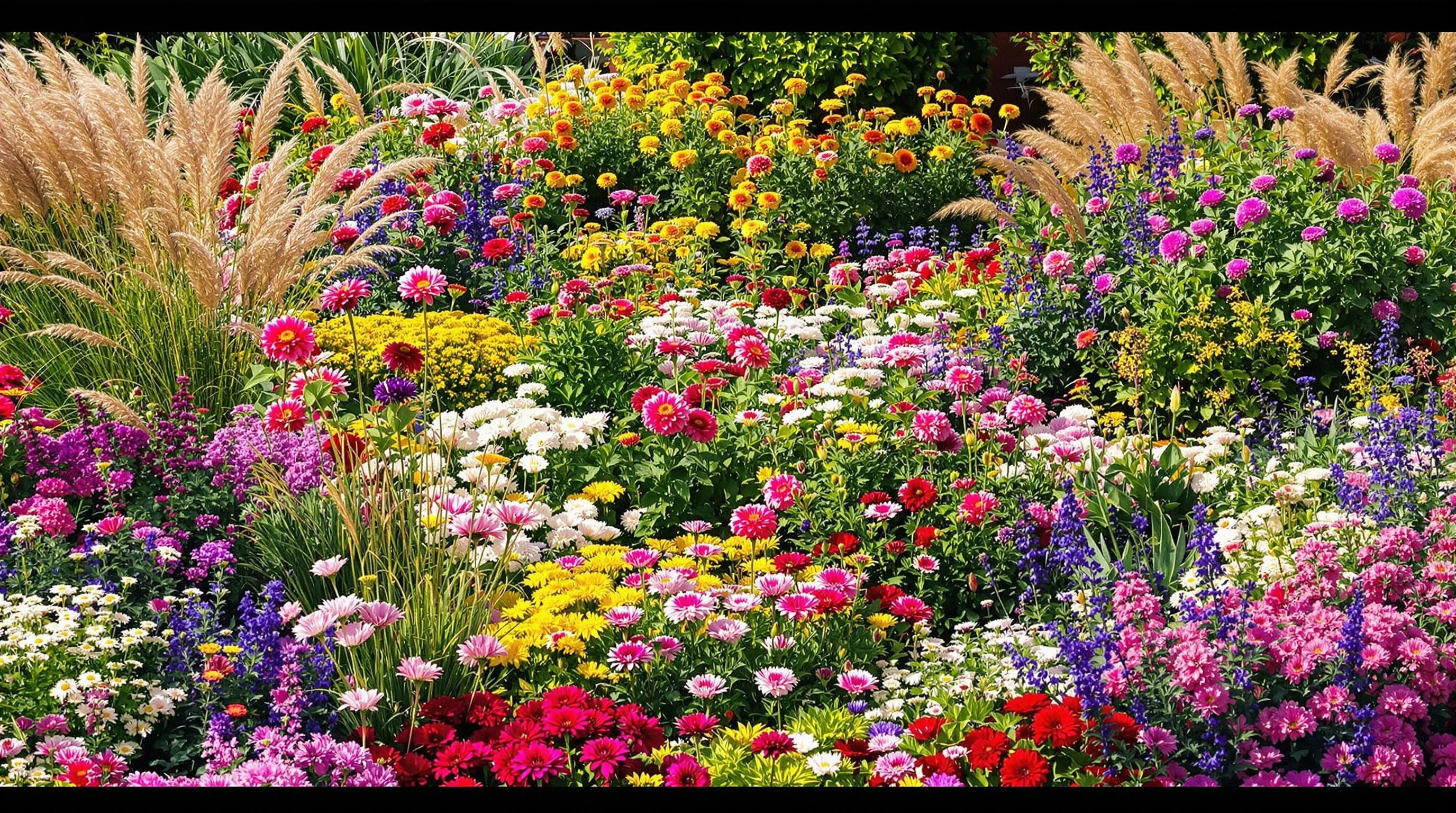
As summer fades, your cottage garden can continue its colorful display with these fall-flowering classics. These resilient plants will extend your garden’s beauty through autumn’s cooler temperatures and shorter days.
Dahlias and Chrysanthemums: Autumn Stars
Dahlias deliver spectacular blooms in countless forms and colors until the first frost. Plant tubers in spring for an explosion of flowers from late summer through fall, with varieties ranging from dinner-plate sized ‘Café au Lait’ to compact pompom types. For best performance, stake taller varieties early and deadhead regularly to encourage continuous flowering. Chrysanthemums offer an equally impressive color palette with their cushion-like blooms in bronze, purple, yellow, and white. Hardy mums like ‘Sheffield Pink’ and ‘Mary Stoker’ return reliably year after year, creating mounds of color when many other perennials have finished blooming. Both plants benefit from a sunny position and regular watering to maximize their fall display.
Sedum and Asters: Late Season Workhorses
Sedums provide both structural interest and crucial late-season nectar for pollinators. ‘Autumn Joy’ and ‘Brilliant’ develop flat clusters of tiny star-shaped flowers that transition from pale pink to rusty red as fall progresses. Their succulent foliage remains attractive throughout the growing season, making them true multi-season performers. Asters create clouds of daisy-like blooms in purples, pinks, and blues from September through October. New England asters (Symphyotrichum novae-angliae) reach impressive heights of 3-4 feet, while New York asters (Symphyotrichum novi-belgii) form more compact mounds. Both thrive in well-drained soil and deliver essential late-season color when paired with ornamental grasses and autumn foliage plants. For best results, divide asters every few years to maintain vigor and prevent center die-out.
6 Winter Interest Plants for Cottage Gardens
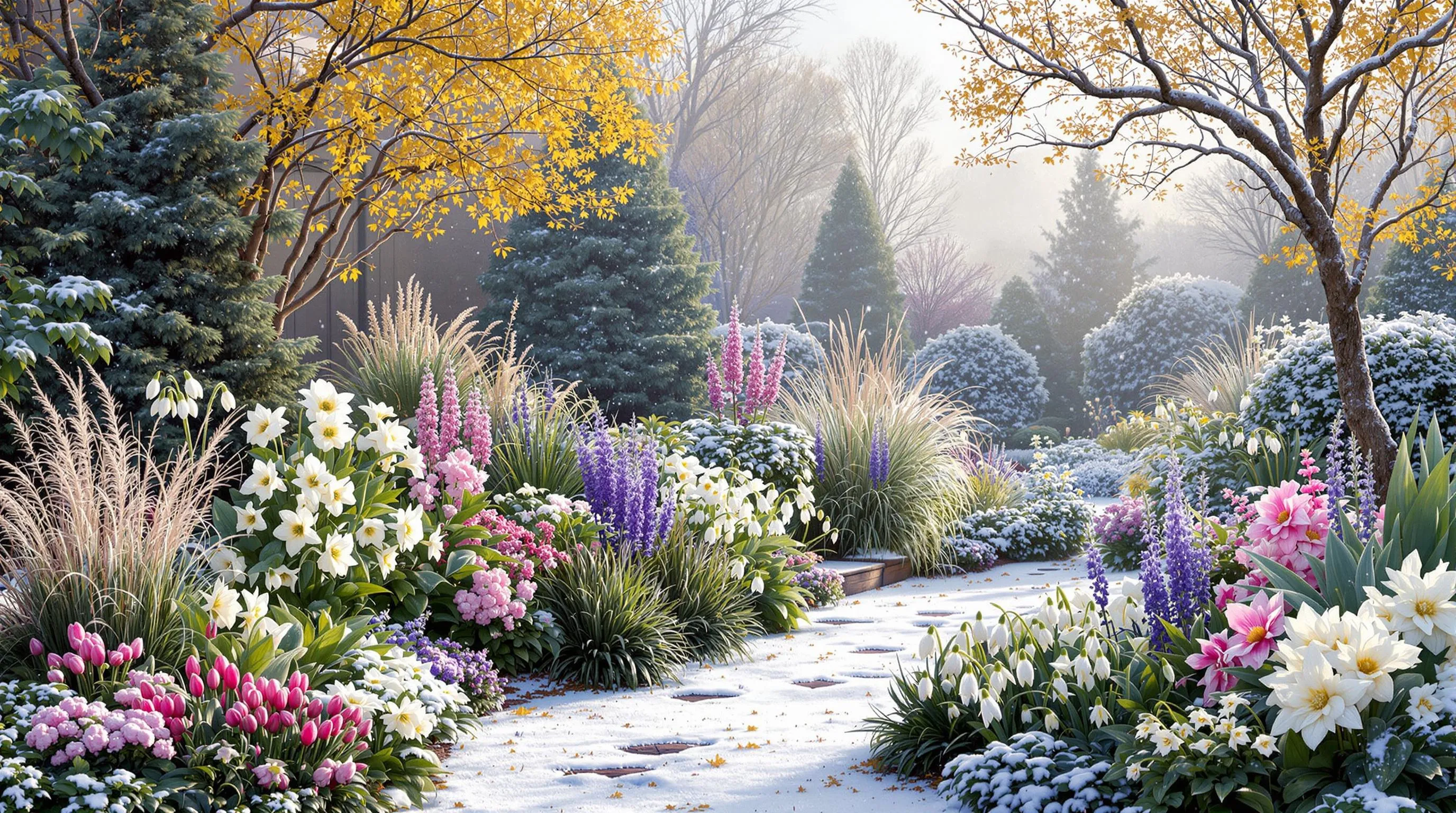
Even in winter’s embrace, your cottage garden can maintain its charm and visual interest. These cold-season performers bring texture, color, and life to the garden when most plants are dormant.
Hellebores: The Christmas Rose
Hellebores stand as the quintessential winter cottage garden plant, producing elegant nodding blooms in the coldest months. Often called Christmas or Lenten roses, these hardy perennials flower from December through early spring in shades of white, pink, purple, and speckled variations. Plant hellebores in dappled shade with well-draining soil, and they’ll reward you with evergreen foliage and frost-resistant flowers. The ‘Ivory Prince’ and ‘Black Diamond’ varieties offer exceptional winter performance, with blooms that persist even through snow. For maximum impact, position hellebores near garden paths where you can appreciate their subtle beauty during winter strolls.
Ornamental Grasses and Evergreen Structure
While summer’s lush blooms have faded, ornamental grasses and evergreen shrubs become the backbone of your winter cottage garden. Miscanthus and Calamagrostis varieties offer striking architectural presence with their dried plumes catching frost and snow. Pair these with compact evergreens like boxwood, yew, or holly for year-round structure and vibrant berries. The silver-blue foliage of Festuca glauca provides striking color contrast against darker elements, while dwarf conifers add varied textures and forms. These structural plants create the perfect backdrop for winter bloomers and offer crucial habitat for garden wildlife during the coldest months.
Winter-Flowering Shrubs
Witch hazel (Hamamelis) brightens the winter garden with its spider-like blooms in gold, orange, and copper tones. These fragrant flowers appear on bare branches from January through March, creating a magical effect when backlit by low winter sun. Viburnum × bodnantense ‘Dawn’ delivers clusters of pink, intensely fragrant flowers from November through March. For smaller spaces, winter-flowering Daphne odora offers powerfully sweet perfume from February onwards, making it perfect near garden entries. Position these shrubs where their scent can be appreciated from pathways or windows to maximize their winter appeal.
Snowdrops and Early Bulbs
Snowdrops (Galanthus) push through frozen ground as early as January, bringing hope of spring’s return. Plant these diminutive bulbs in drifts beneath deciduous trees or among hellebores for a classic cottage garden combination. Winter aconites (Eranthis hyemalis) follow with bright yellow buttercup-like blooms, while early crocuses add purple, white, and yellow accents to the awakening garden. For the most extended display, combine early, mid, and late-flowering snowdrop varieties. These resilient bulbs multiply yearly, eventually forming impressive colonies that announce winter’s end.
Winter-Flowering Heathers
Low-growing heathers (Erica carnea) provide essential winter color with their masses of tiny bell-shaped flowers in white, pink, and purple hues. These acid-loving evergreens bloom from December through April, creating carpets of color when little else flowers. Varieties like ‘Springwood White’ and ‘December Red’ offer months of reliable blooms even in harsh conditions. Plant heathers in groups of three or five for maximum impact, using them to edge paths or fill gaps between larger shrubs. Their fine texture contrasts beautifully with bolder evergreens and provides valuable nectar for early-emerging pollinators.
Mahonia and Winter Berries
Mahonia × media ‘Charity’ produces spectacular spikes of fragrant yellow flowers from November through March, followed by blue-black berries. This architectural evergreen brings dramatic vertical interest to winter gardens and thrives in difficult shady spots. Complement mahonia with berry-producing plants like holly (Ilex), cotoneaster, and callicarpa, whose purple “beauty berries” persist well into winter. The red stems of Cornus sanguinea (dogwood) provide vibrant color through the darkest months. Position these plants where birds can safely feast on their berries, bringing additional movement and life to your winter cottage garden.
Design Tips for Continuous Color in Your Cottage Garden
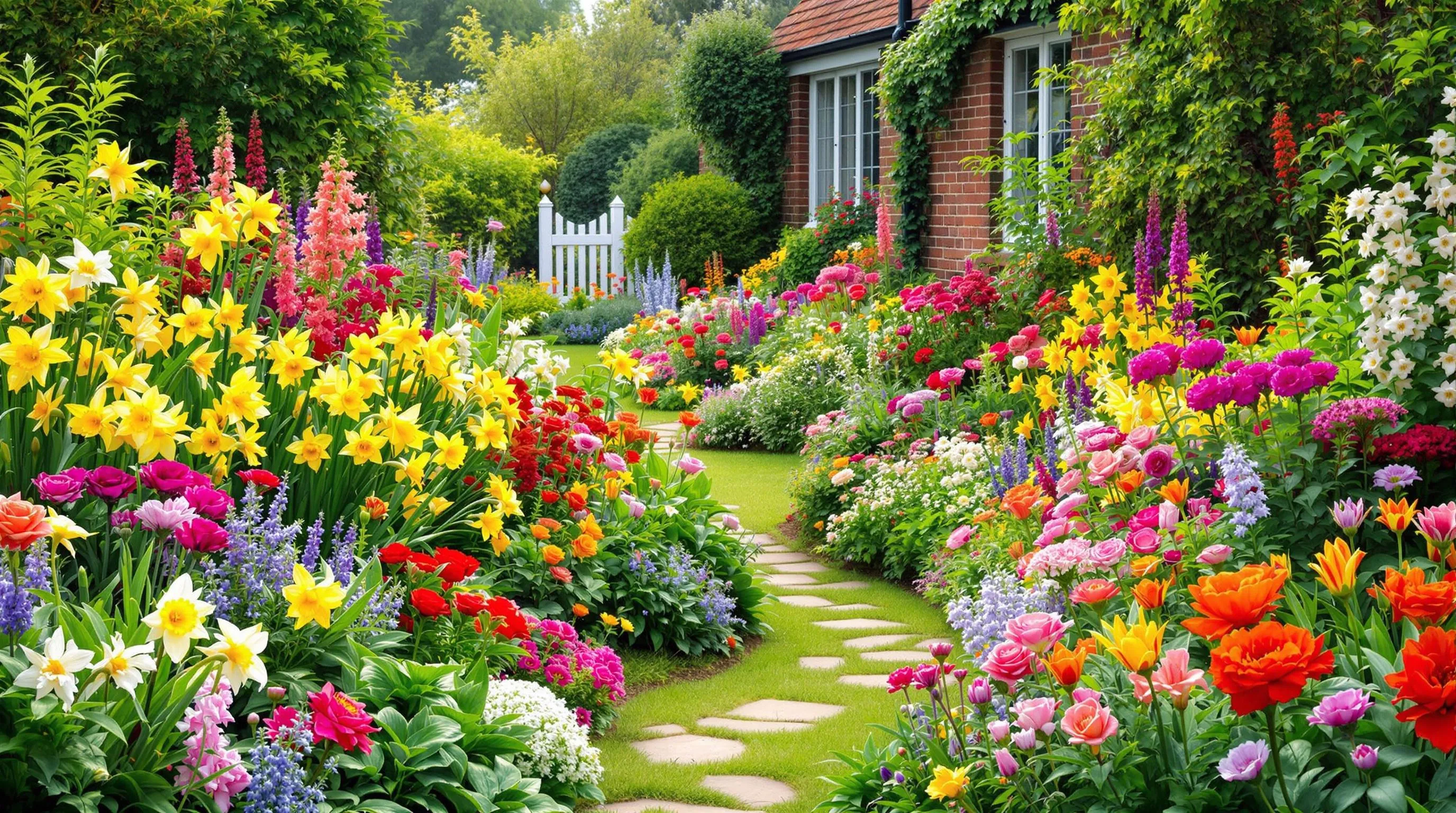
Creating a cottage garden that maintains its charm throughout the seasons requires thoughtful design strategies. These practical approaches will help you orchestrate a symphony of color that unfolds seamlessly month after month.
Companion Planting for Seamless Transitions
Companion planting is your secret weapon for achieving continuous color. Pair early bloomers with mid-season and late-flowering plants to ensure something is always catching the eye. Plant spring bulbs like daffodils beneath later-emerging perennials such as hostas or daylilies—the emerging perennial foliage will hide the bulbs’ fading leaves. Position billowing catmint alongside roses to provide complementary color when the first flush of roses begins to fade. Underplant tall delphiniums with spreading geraniums that will flower after the spires have finished. This thoughtful pairing creates a garden where one plant’s decline is always balanced by another’s peak, maintaining visual interest without obvious gaps in blooming periods.
Succession Planting Strategies
Carry out succession planting to extend your garden’s flowering season dramatically. Start by mapping your garden’s bloom times on a calendar to identify potential color gaps. Plant in layers with early, mid, and late-season varieties of the same flower types—for example, early, mid, and late tulips can stretch spring color for weeks longer. Incorporate quick-growing annuals like cosmos and calendula between slower-developing perennials to fill temporary spaces. Don’t hesitate to plant in waves, adding new seedlings as earlier blooms fade. Strategic deadheading encourages additional flushes of flowers on many perennials, while allowing some plants to self-seed creates natural succession from year to year. Remember that foliage matters too—plants with colorful or variegated leaves like heucheras provide lasting visual interest between flowering periods.
Maintaining Your Classic Cottage Garden Through the Seasons
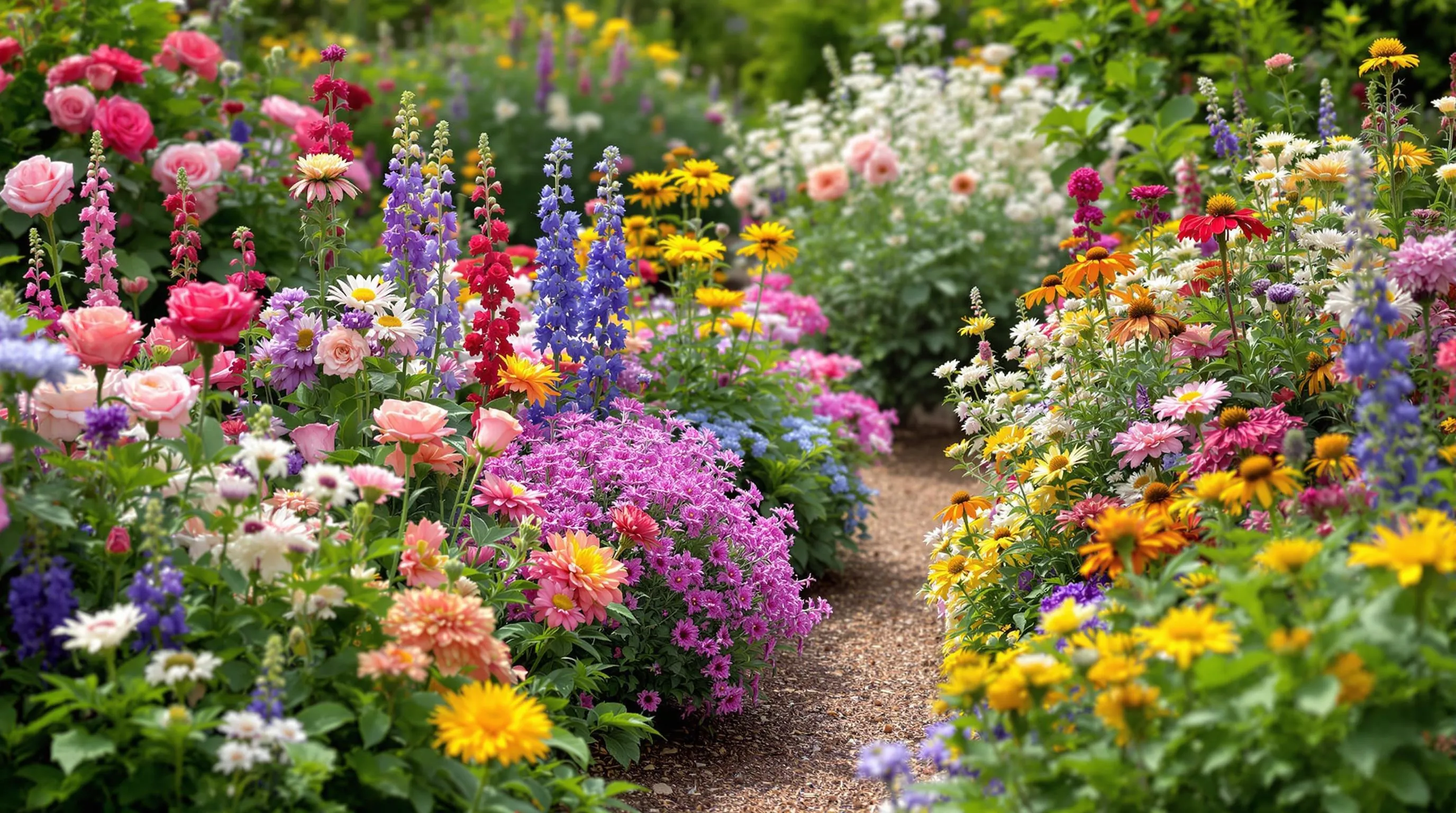
A successful cottage garden requires thoughtful maintenance throughout the year to preserve its charm and continuous display of color. By following a consistent care routine, you’ll ensure your garden thrives season after season.
Seasonal Care and Pruning Schedule
Spring maintenance focuses on clearing winter debris and preparing for the growing season. In early spring, cut back ornamental grasses and remove dead foliage from perennials to make way for new growth. Apply a layer of compost around plants to replenish nutrients while being careful not to bury emerging shoots. Summer care centers on deadheading spent blooms—particularly on roses, delphiniums, and foxgloves—to encourage repeat flowering and prevent unwanted self-seeding. Water deeply during dry spells rather than frequently and shallowly to promote strong root development. Fall preparation includes cutting back perennials after the first frost, leaving seedheads on plants like echinaceas and rudbeckias for winter interest and bird food. Apply a protective mulch around tender perennials like dahlias if you plan to overwinter them in the ground. Winter tasks focus on structural maintenance—prune deciduous shrubs during dormancy and cut back climbers like clematis according to their exact pruning group requirements to avoid removing spring-flowering buds.
Dividing and Propagating for Fuller Gardens
Dividing overcrowded perennials rejuvenates your cottage garden while providing free plants to fill gaps or expand your planting scheme. Split spring-flowering perennials like primroses and pulmonarias in early fall, and divide summer-flowering plants like daylilies and phlox in spring when new growth appears. Look for signs that division is needed: decreased flowering, plants with dead centers, or clumps that have outgrown their space. When dividing, use two garden forks back-to-back to gently pry perennial clumps apart, ensuring each division has healthy roots and several growth points. Take softwood cuttings from lavender, salvias, and other woody perennials in early summer for propagation. For prolific self-seeders like foxgloves and columbines, allow some plants to set seed and gently redistribute seedlings to maintain the garden’s informal, abundant character. This approach creates a sustainable garden that evolves naturally while maintaining its classic cottage charm—with minimal expense and maximum satisfaction.
How to Incorporate Modern Varieties While Keeping the Classic Cottage Look

Today’s modern plant varieties offer improved disease resistance, longer blooming periods, and more compact growth habits—without sacrificing the charm of a traditional cottage garden. Start by selecting modern cultivars that maintain the loose, informal flower shapes of heritage varieties, such as reblooming delphiniums or mildew-resistant bee balm. Layer these alongside classic cottage favorites, positioning them based on their mature height and spread rather than in rigid rows. Blend colors that complement rather than clash, using the traditional cottage palette of soft pinks, purples, whites, and blues as your foundation. Incorporate structural elements like weathered trellises or vintage containers to enhance the timeless feel while showcasing newer varieties. Remember to embrace some controlled chaos—allow plants to self-seed and intertwine naturally, even if they’re modern cultivars. This approach gives you the best of both worlds: the nostalgic charm of a cottage garden with the improved performance of contemporary breeding.
Creating Cottage Garden Magic in Limited Spaces
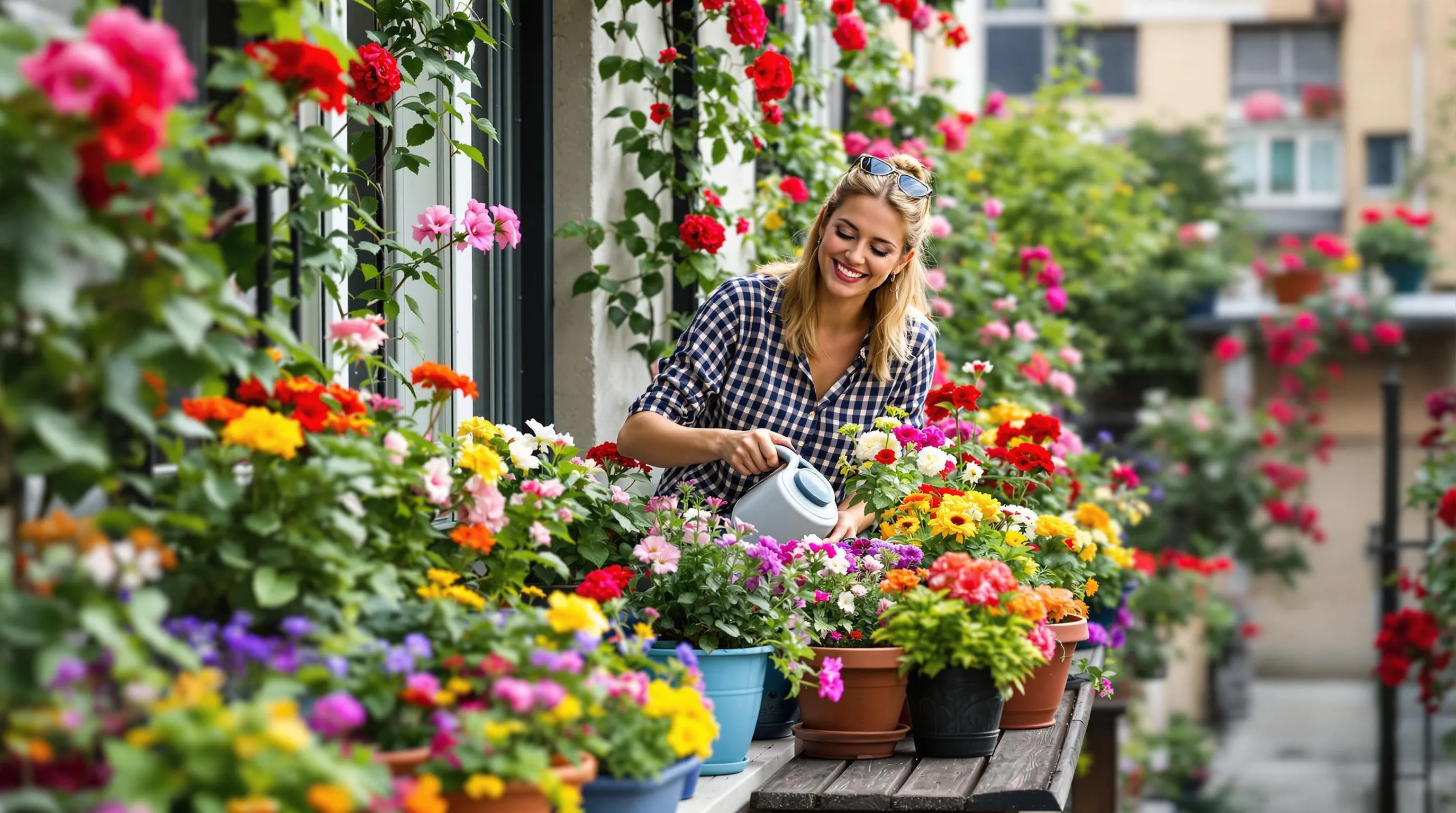
You don’t need a sprawling country yard to create cottage garden charm. Even balconies, small urban yards, and container gardens can capture that quintessential cottage style. Focus on vertical growing with climbing roses, clematis, or morning glories on trellises to maximize limited space. Choose multi-tasking plants like compact lavender varieties (‘Munstead’ or ‘Hidcote’) that offer fragrance, flowers, and structure in small footprints. Use containers strategically—cluster terra cotta pots of different heights filled with bellflowers, compact geraniums, and trailing nasturtiums for a layered look. Consider dwarf varieties of cottage classics, such as shorter delphiniums (like ‘Summer Nights’) and compact foxgloves (‘Foxy’) that deliver the same cottage aesthetic without overwhelming small spaces. Create the illusion of depth by placing taller plants at the back and shorter ones in front, using mirrors strategically to double the visual impact of your plantings. Remember that cottage gardens traditionally mixed ornamentals with edibles, so intersperse compact herbs like thyme, chives, and dwarf varieties of sage among your flowering plants for authentic charm and practicality in limited growing areas.
Conclusion: Cultivating a Timeless Cottage Garden Palette
Your cottage garden can truly be a haven of continuous color and charm throughout the year. By thoughtfully selecting plants for each season you’ll create not just a garden but a living tapestry that evolves with time.
Remember that the most enchanting cottage gardens embrace both structure and spontaneity. Allow your carefully chosen spring bulbs summer perennials fall bloomers and winter interest plants to mingle freely creating that signature cottage garden magic.
Whether you have acres of land or just a few containers the cottage garden style adapts beautifully to any space. With strategic planning companion planting and seasonal maintenance your garden will reward you with waves of color fragrance and life from January through December.
The joy of a cottage garden lies in its evolution – always changing always blooming always inviting you to step outside and experience nature’s endless palette.

